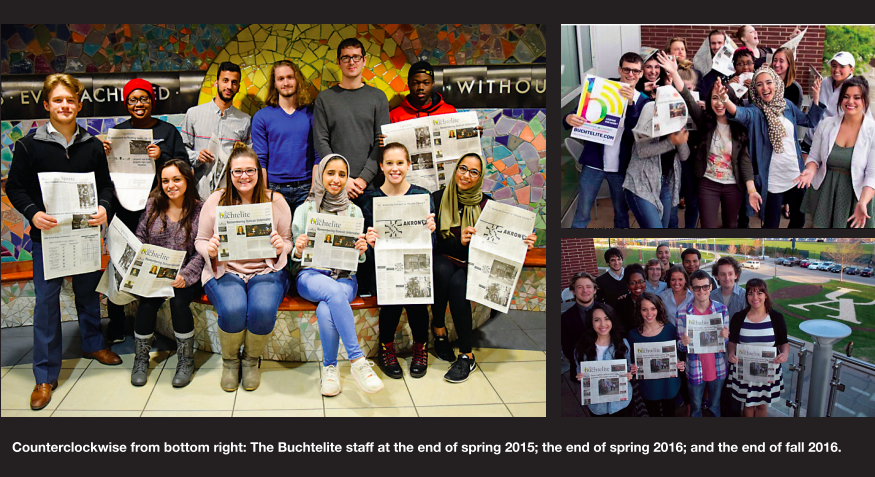“Mack Rhoades stood over his desk, placed his hand on his jaw and sighed. We have to get a football stadium built, said the University of Akron’s athletic director. The Rubber Bowl prohibits us with attendance – especially with students, he continued.”
“
Mack Rhoades stood over his desk, placed his hand on his jaw and sighed.
We have to get a football stadium built, said the University of Akron’s athletic director.
The Rubber Bowl prohibits us with attendance – especially with students, he continued. The lack of amenities, the deteriorating seats, et cetera. It prohibits us from maximizing revenue.
Having the $54 million on-campus stadium ready for 2009 is a goal held by many at the university, but especially by the fans.
An entirely different contingency among the university community is asking, Why bother?
UA subsidized its athletic department $13.1 million last year. That is $13.1 million that could have gone to improve academic programs, they say.
The football program alone lost more than $3 million. No sport came even close to breaking even (see chart on A2).
Also, coaches spent $500,000 last year in recruiting. In layman’s terms, the university is paying $500,000 to coax high school students to accept a full-ride scholarship at UA. It’s a double whammy.
Rhoades offers several defenses against these points.
Although Akron sports don’t come close to paying for themselves, only a handful of the teams at the 119 Division IA schools do.
The national standard is that a university subsidizes athletics with about 5 percent of its total budget. The $13.1 million subsidy is just less than 4 percent of UA’s $345 million budget.
Some sports also help by attracting paying students. The track team, which awards only a small fraction of its 90 athletes with scholarships, increases tuition by attracting students to UA, who normally would go elsewhere. That figure could reach $1 million for the track team alone.
We are, by far, a great bargain with what we bring in and provide, track coach Dennis Mitchell said.
About 200 athletes on campus are without a full scholarship, Rhoades said. Those students pay tuition, but that money is not calculated as athletics revenue.
Rhoades also points to the publicity sports garner for a university. The football team will play twice on ESPN next season. Ninety million homes receive that network, and each of the viewers, conceivably, could walk away from the television set with a higher level of respect for UA.
For most universities, the greatest marketing window is athletics, Rhoades said. It can lead people to investigate the academics, which is most important.
Another intangible benefit is the cohesion that university athletics offer.
It can be a focal point of celebration, Rhoades said. If you’re winning, it brings a sense of school spirit to the campus.
Still, Rhoades said his department must improve upon the $3 million in total revenue it generated last year.
The department has improved already since Rhoades arrived in January 2006. Football ticket sales brought in $349,000 last season, which is double the total from 2005 when Akron won the Mid-American Conference Championship. With Keith Dambrot’s Zips winning 26 men’s basketball games, attendance income jumped 15 percent to $270,000, and that’s even with a massive blizzard wiping out attendance for the game against Ohio University which was expected to be a big money maker.
Women’s basketball is considered the third-largest collegiate sport. Akron’s team brought in only $25,800 last year. That is a figure with perhaps the highest potential to grow, Rhoades said.
It hasn’t been a successful program, Rhoades said. People want to see a quality product. Before we can think about making money, we have to have a better product.
That illustrates the importance of winning to a financially successful institution. Take Ohio State University, for example. The Buckeyes were national runners-up in men’s basketball and football. OSU’s budget of $98 million reflects that. It is the highest of any department in the nation.
Merchandise sales at Ohio State also boost revenue significantly. It’s hard to walk anywhere without seeing a Buckeyes shirt or baseball cap, even on UA’s campus.
UA’s merchandising is not so lucrative. The university hires Licensing Resource Group, Inc. to protect its brand and logo. LRG collected about $50,000 last year from manufacturers, such as Nike or New Era, who sold Zips merchandise in retail stores or over the Internet. Of course, the university sells merchandise itself at the team stores at Rhodes Arena and the Rubber Bowl. Those ventures earned UA $168,000 in 2006.
Although the football team loses millions of dollars, it recoups plenty through buy games, which are road games the university plays against bigger schools for a large paycheck.
The going rate is about $600,000 that a large school, such as the University of Michigan, will pay an institution from a mid-major conference, such as Akron, to travel to Ann Arbor, Mich., for just one game.
With travel expenses rarely reaching higher than $80,000, this can become somewhat of a welfare system to the smaller schools. Akron will play two such away games next season: at Ohio State and Connecticut.
These revenue enhancing methods are nice, but the truth is, UA’s athletic budget sits at $16 million – which is in the lowest third of the teams in the MAC.
Rhoades believes the new stadium can help boost revenue, and thus, increase the budget from which he can draw.
We have to increase the amount of revenue we generate, Rhoades said. That is our focus.
“
” #1.1362038:2160949214.jpg:MACK_tease.jpg:Athletic director Mack Rhoades says Zips sports create a sense of school spirit and a point of celebration for UA.:”

